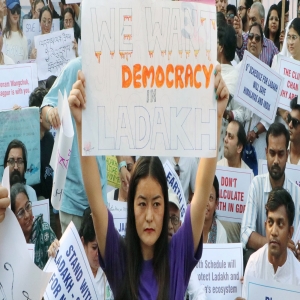

Each generation carries its own scepticism about life's outlook and proclaims, "after them, the deluge," especially when judging a generation seemingly consumed by the troika of social media, processed food, and online games. However, Gen Z (defined as those born between 1997 and 2012) has proved to be far more nuanced.
From Bangladesh last year to Nepal, Morocco, Madagascar, and Kenya, recent events show that the spirit of revolution has not died but has instead been checked by the perils of state-owned technology and surveillance. The changing nature of social movements marks a shift from the "old" to the "new."
Firstly, there has been a move from demands focused on basic needs such as food, water, and shelter to those seeking better standards of living.
Secondly, new social movements often reflect cross-cutting identities, with people from diverse backgrounds participating, as seen during the farmers' protests, when trade unions and students stood together.
Thirdly, these protests are decentralised and go beyond party politics, showing grassroots democracy in action rather than parties fulfilling their own agendas.
Fourthly, they are often leaderless at the start, mobilised through social media before eventually forming a vanguard organisation to sustain momentum. Yet, history shows that leaderless movements tend to collapse over time.
Can similar protests happen in India?
Social movements in India exhibit traits of both old and new forms. A significant portion of the population remains deprived of basic needs, so the demand for a better standard of living can only arise once people have a foundation to build upon.
The women's rights movement is an apt example of this overlap. While women demand workplace equality and equal pay, there is also a parallel push to "reclaim the night," symbolising the pursuit of a better quality of life.
The closest India has come to a Gen Z-style protest in recent times was in Ladakh, where students, working professionals, and academics united to demand Sixth Schedule protections. However, the movement's momentum was halted with the detention of its most visible leader, Sonam Wangchuk, under the National Security Act.
While Gen Z possesses the intelligence to understand political nuance, the courage to protest, and the tolerance for multiple identities, sustaining a movement in India would require three key conditions:
1. A continuous channel of communication. This remains weak due to the rise of surveillance capitalism and the nexus between state and technology. The Californian fires case, where a suspect was tracked after querying ChatGPT about the causes of forest fires, shows how easily digital footprints can be monitored.
2. Freedom from the fear of prosecution. Draconian laws like the UAPA, PSA, and NSA create a sense of deterrence among the youth. This fear may hold until frustration from cronyism or jobless growth, as seen in Nepal, reaches a tipping point.
3. The presence of leadership to guide and sustain the masses. In Ladakh, Wangchuk's detention and the revocation of his NGO's FCRA license reinforced the perception that dissent risks being branded anti-national.
That said, Ladakh may not be the ideal benchmark for gauging whether Gen Z protests can take root in India, given its sensitive geography at the trijunction of China and Pakistan, especially at a time when China is using initiatives like the Belt and Road and the Global Development Initiative to exert regional influence.
Two developments must happen simultaneously. First, the government must remain true to its promise of Next Gen reforms and address Gen Z's concerns, particularly in areas such as job creation, environmental protection, and freedom of ex